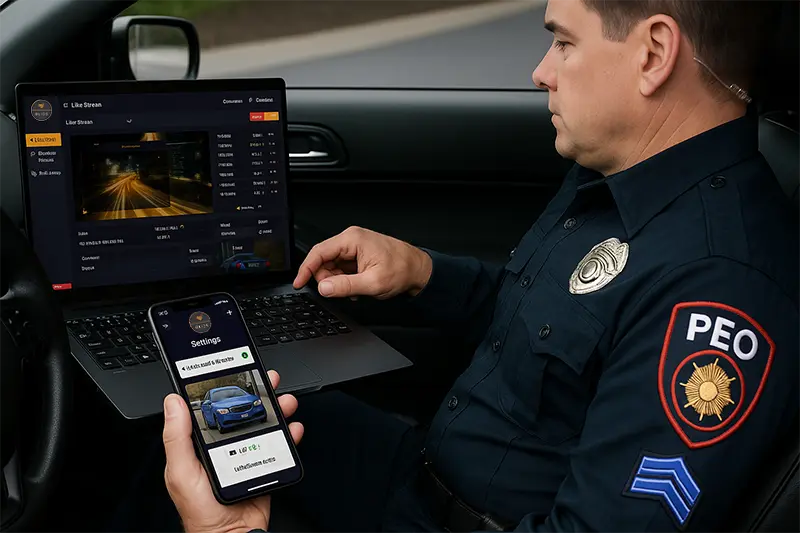OLIOS Patrol –
PEO Parking Violation
Detection Application
for Smarter Cities
Transform parking enforcement with OLIOS — an AI-powered application that uses real-time license plate recognition (LPR), GPS tracking, and smart alerting to detect and manage parking violations effortlessly. Designed for enforcement officers on the move, OLIOS ensures fast, accurate, and reliable violation detection from vehicle or mobile patrols.

Key Features
Real-Time LPR Detection
- Instant license plate recognition from multiple cameras mounted on patrol vehicles.
- High accuracy in varied lighting and weather conditions.
- Also available via mobile phone camera for narrow street enforcement.
Violation Detection Intelligence
- Zone Violation: Identifies vehicles in restricted or unauthorized parking zones.
- Overtime Parking: Flags vehicles that exceed paid or allowed parking time.
- Unpaid Parking: Detects unpaid vehicles using real-time integration with payment systems.
- Stolen Vehicle Detection: Checks plates against police and stolen vehicle databases.
Auto Ticket Generation
- Instantly generates e-tickets with metadata including images, timestamp, location, and violation type.
- Reduces officer workload and improves accuracy.
GPS & Geo-Fencing
- Real-time GPS tracking of PEO vehicle or mobile officer.
- Logs location of every violation and patrol route.
- Geo-fenced zones with auto-alerts when a violation occurs in restricted or sensitive areas.
Visual Evidence Collection
- Auto-capture of high-resolution images and video clips of violations.
- Includes license plate overlay, GPS coordinates, timestamp, and violation type.
- Multi-camera support for optimal viewing angles.
Smart Siren Activation
- Automatically activates a siren when stolen or high-risk vehicles are detected.
- Configurable based on GPS zones (e.g., silence near schools/hospitals).
- Supports internal laptop speakers and external vehicle-mounted sirens.
Real-Time Alerts & Dashboard
- Immediate on-screen notifications for:
- Stolen vehicle matches
- Repeat violators
- Vehicles with multiple unpaid fines
- Dashboard view with live camera feeds, maps, alerts, and system status.
Mobile Enforcement App
- For small or inaccessible streets, officers can use the mobile app.
- Captures vehicle images, performs LPR on the device or cloud, and uploads violations.
License Plate Lookup & Violation History
- Officers can search any plate to view past violations, payments, and appeal history.
- Helps identify repeat offenders instantly.
Seamless Backend Integration
Real-time sync with:
▪ Police & municipal databases
▪ Court systems (optional)
▪ Multiple payment gateways (apps, SMS, meters)
Offline Mode with Auto-Sync
- Detect and log violations without network connectivity.
- Auto-syncs all data when the system reconnects.
Role-Based Access Control
- Different permissions for Admins, Officers, Auditors, and Supervisors.
- Full activity logs and audit trails
Manual Entry & Override
Officers can manually record observations or override false positives.
Multilingual Support
Interface localization for international deployment and diverse teams
Why Choose OLIOS?
Parking violations cost cities millions in lost revenue, increase congestion, and reduce public satisfaction. Traditional enforcement methods are reactive, manual, and inefficient. OLIOS automates detection, streamlines enforcement, and keeps officers safe all while enabling real-time data collection and smart decision-making.
Benefits at a Glance
Boost enforcement accuracy and speed
Reduce manual workload and human error
Improve safety with automatic threat alerts
Enhance public trust with fair, data-driven enforcement
Integrate with existing city infrastructure and platforms
Frequently Asked Questions
How does OLIOS detect a parking violation?
OLIOS uses real-time License Plate Recognition (LPR), GPS-based geofencing, and integration with
payment and police databases to detect violations like overtime parking, unpaid vehicles, zone
breaches, and stolen cars.
Can OLIOS work without internet connectivity?
Yes. OLIOS has an offline mode that allows it to detect and log violations locally. Data automatically
syncs with the server once connectivity is restored.
Is it only for vehicles with mounted cameras?
No. While OLIOS supports vehicle-mounted LPR cameras, it also includes a mobile app version for
use in narrow streets where patrol vehicles can’t reach. The phone camera performs LPR and sends
data to the central system.
Can the system trigger sirens automatically?
Yes. OLIOS can activate internal or external sirens when a stolen vehicle or a critical violation is detected. You can also configure GPS zones where sirens stay silent (e.g., near hospitals or schools).
Can officers manually override system decisions?
Yes. Officers can manually flag or dismiss violations, enter comments, or override automated actions
when necessary.
How accurate is the LPR in poor lighting or weather?
OLIOS uses enhanced LPR algorithms optimized for challenging environments — including low light, rain, and glare — with high detection accuracy.
Does OLIOS integrate with existing municipal or police systems?
Absolutely. OLIOS supports integration with stolen vehicle databases, payment gateways, court systems, and citizen portals via APIs or custom connectors.
Is the data secure and compliant with regulations?
Yes. All data is encrypted, access-controlled, and follows local data protection laws (e.g., GDPR). Retention and deletion policies can be configured to meet your compliance requirements.
Can I use this in a multilingual environment?
Yes. OLIOS supports a multilingual interface to accommodate diverse officer teams and regional deployments.
What hardware is required to deploy OLIOS?
You’ll need a laptop with camera feeds for the in-vehicle system, or a smartphone for the mobile version. Internet connectivity (optional), GPS, and external siren support are available for advanced features







